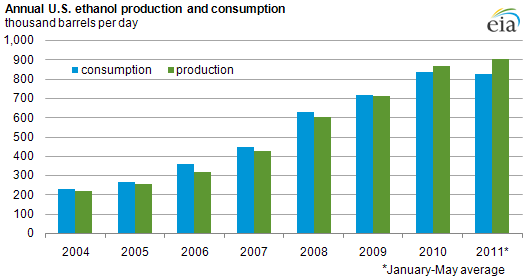
Growth slows in U.S. ethanol production and consumption

Download CSV Data
During the first five months of 2011, U.S. fuel ethanol production increased 59,000 barrels per day (bbl/d) (6.9%) compared with the same period in 2010. This represents a slower rate of growth compared with 2010 when production during the first five months was 194,000 bbl/d (29.7%) higher than the same period in 2009, and 154,000 bbl/d (21.6%) higher for the whole year. In April 2011, the year-over-year growth rate of ethanol production hit 4.7%, the lowest of any month since May 2001.
The slowing growth in U.S. fuel ethanol production is due partly to sluggish domestic demand for fuel ethanol. Consumption of fuel ethanol grew more slowly (23,000 bbl/d, or 2.8%) than production during the first five months of 2011. April consumption was 10,000 bbl/d (1.2%) lower compared with April 2010, the first time a month registered a year-over-year decrease since July 2002.
Slowing growth in fuel ethanol consumption is likely attributed to the following factors:
- Saturation in the gasoline market. Nearly all fuel ethanol currently used in the United States is consumed as a blend with gasoline in volumes containing up to 10% ethanol (E10), which until late 2010 was the legal limit for ethanol blends sold for use in vehicles designed to run on gasoline. As fuel ethanol use has grown, the market for E10 blending has neared the saturation point, also known as the ethanol blend wall. In October 2010 and January 2011, EPA issued waivers allowing ethanol blends of up to 15% (E15) in vehicles manufactured after 2000. However, near-term barriers to the marketing of E15 may slow the transition to higher blends due to concerns over potential mis-fueling, associated liabilities, and other issues.
- Vehicle and infrastructure issues. Similarly, growth in sales of fuel ethanol as E85 (85% ethanol, 15% gasoline) is restricted in the near term by the number of flex-fueled vehicles that can burn this fuel and the limited availability of E85 refueling stations.
- Lower gasoline consumption. U.S. gasoline consumption was 161,000 bbl/d (1.8%) lower through May 2011 compared to the same period in 2010; lower gasoline demand reduces the amount of ethanol needed for gasoline blending at any given blending ratio.
As a result, export markets reflect a growing outlet for excess ethanol. Beginning in February 2010, the United States has consistently been a net exporter of fuel ethanol. For the first five months of 2011, U.S. fuel ethanol exports totaled 62,000 bbl/d; exports during the same period in 2010 were only 22,000 bbl/d.